Touring the area my grandmother grew up, only a few hints of the coal mining history remain.
By Willis Bretz
Alone and seven years old, my great-grandfather, Michael Hardisky, came to America from Austria in 1891. He made the trip after an uncle living in America sent for him after learning he had no one to care for him in Austria. Growing up and as an adult, the topic was not talked about within the family as there was always a fear of him being sent back to “old country” as they called it. These are things I recently learned while talking with my grandmother, Loretta Yasher, about our family history. Growing up on No. 2 Mine Rd. in Volant, PA, my grandmother eventually came to realize her father couldn’t read. She describes him as quiet and attributes that to her belief that he did not learn much English if any at all. When he would speak, she remembers he would speak Slovak and immediately be hushed by my great-grandmother, Mary Hlopko Hardisky. My grandmother recalls her mother’s scoldings, “You can’t speak like that! Someone may hear you. You want to go back to old country?” With a minimal English vocabulary and no reading or writing skills, my great-grandfather worked as a coal miner in Buhl No. 2 Mine in Volant, PA to support his wife and 16 children.
The coal mines of western Pennsylvania and throughout the region fueled steel mills as they produced building materials used across America during the industrial age. Operated by Sharon Coal & Limestone Co., Buhl No. 2 Mine was one of those mines. Michael, however, was not the only person in the family working in the mine. His sons Johnny, age 11, and Billy, age 9, joined him in the depths of the mine to help the family get by, as was common during that time. My grandmother shared a story with me about her brothers working in the mine. At one point, her father was not able to keep up with the demand of the work required of him in the mine. Working alongside his father, Johnny picked up the slack and completed not only his work, but his father’s as well. Their boss eventually heard of this and became upset that Michael was not completing his work. Johnny wasted no time and yelled at the boss, “Does the work get done?” The argument went no further because the work was completed. After returning home from that day’s shift, my grandmother recalls her father yelling at Johnny, “They could get me, and I’d have to go back. Don’t ever do that again! You want me to go back to old country?” Another example of the continued fear he had of having to return to Austria.
Eventually, Buhl No. 2 Mine was closed as strip mining moved into the area. No longer working in the mine, my grandmother’s family moved to New Castle, PA and her brothers got jobs in the steel mills in Farrell, PA. Michael never worked again after the mine closed and his strength declined. Years later, he died on August 1, 1962 from black lung disease, also known as coal workers’ pneumoconiosis (CWP). His death certificate reports he was 78 years old, but this number is not exactly accurate as his date of birth was never known. My grandmother recalls, “We never knew how old he was. He didn’t know a birthday. We made one up for him one time. I don’t know if it was Johnny or one of them said, ‘Well, we’ll just make him a birthday.’ Cause everybody would celebrate their birthday, but he never did.”
Touring the area my grandmother grew up, only a few hints of the coal mining history remain. No. 2 Mine Rd. intersects with the now trackless railroad bed that once carried coal from Buhl No. 2 Mine. Not too far from there, the old road that once led to the mine’s entrance is still visible. It is now an overgrown path that cuts into the wooded area along No. 2 Mine Rd. The entrance to Buhl No. 2 Mine no longer exists after it and the mine itself were destroyed by the strip mining that occurred in the area. Other than No. 2 Mine Rd. itself, perhaps the most noticeable piece of coal mining history in the immediate area is the old company store. Company stores were owned and operated by coal mining companies. Located on the corner of Brent Rd. and Old Ash Rd. in Volant, PA, the company store was where miners and their families could buy goods with the scrip they earned from working in the mines.
There is however, one heirloom, that reminds our family of its history and the laboring work that was done to provide for it years ago. As mentioned earlier, Johnny worked in Buhl No. 2 Mine with his father. Throughout the years, he kept the coal mining hat that his father wore while working in the mine. Since Johnny’s passing in 2021, my grandmother, the last living sibling of 16 brothers and sisters, is now in possession of the coal mining hat. The hat is missing its lamp but exhibits scars from the work completed by Michael in the mine. It is misshaped, scratched, and cracked. There are also dime and nickel-sized holes punctured on each side of it, possibly to provide ventilation while wearing it. The leather headband inside is well worn. Possibly the most interesting part is how the straps are tied together in the center by a green cord or possible boot lace. My great-grandfather tied it like that to fit his head so many years ago, and it remains tied today as it was then. A lasting personal relic cherished by our family.
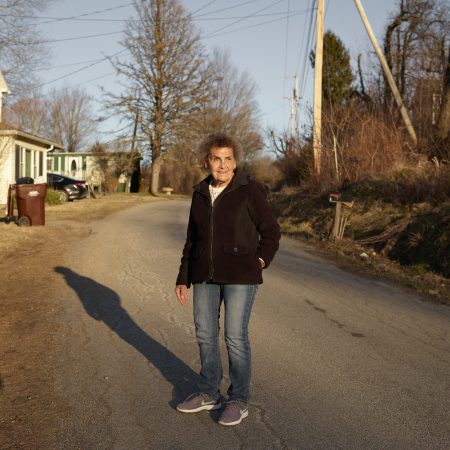
My grandmother, Loretta Yasher, standing on No. 2 Mine Rd. in Volant, PA where she lived as a young child with her parents, Mary and Michael Hardisky, and 15 brothers and sisters.
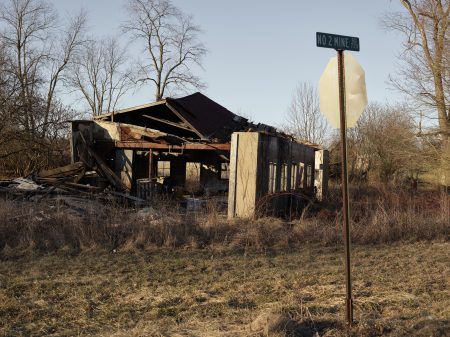
What was once a gas station that served coal mining families on the corner of No. 2 Mine Rd. and Brent Rd. in Volant, PA is now a partially collapsed shell of a building.

My mother, Kim Bretz, standing with her mother, Loretta Yasher, as they look at what remains of a gas station on the corner of No. 2 Mine Rd. and Brent Rd. in Volant, PA where my grandmother would purchase candy as a young child while living on No. 2 Mine Rd.

A rusted dump truck parked at the corner of No. 2 Mine Rd. and Brent Rd. in Volant, PA next to the partially collapsed gas station that once served coal mining families.

The old railroad bed trains would travel on when hauling coal from Buhl No. 2 Mine in Volant, PA.

The former road leading to the entrance of Buhl No. 2 Mine in Volant, PA.

The former coal mining company store still stands at the corner of Brent Rd. and Old Ash Rd. in Volant, PA. Instead of money, coal miners were paid in scrip, a form of currency used exclusively at company stores where they and their families could purchase goods of all kinds.

My grandmother, front and center, sitting with her brothers on the porch of their home on No. 2 Mine Rd. in Volant, PA. Billy is sitting in the front on the left while Johnny sits in the back on the right.

A family photo taken on my grandparents’ wedding day, February 11, 1956, with my great-grandfather, Michael Hardisky, seated in the front row.
Below: The mining hat worn by my great-grandfather, Michael Hardisky, while he worked in Buhl No. 2 Mine that was operated by Sharon Coal & Limestone Co. in Volant, PA. Years later after leaving the mine, records show he passed away on August 1, 1962 at age 78 from black lung disease, also known as coal workers’ pneumoconiosis (CWP). His age at death is not exactly clear, however, as his official date of birth was never known.
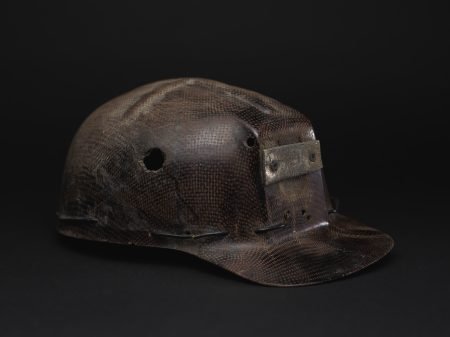


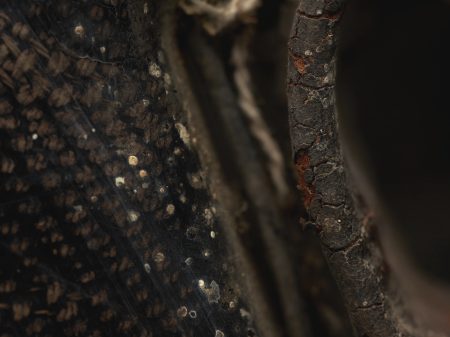
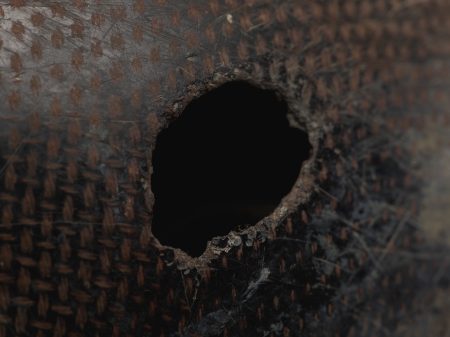
Willis Bretz is a portrait and documentary photographer based in Washington, DC. He earned a BA in history at Westminster College while also studying art and photography.






